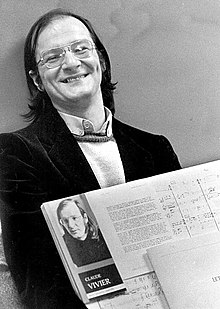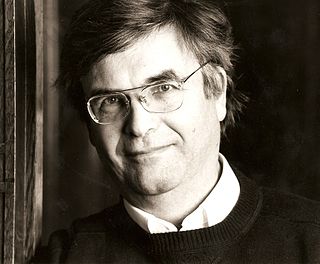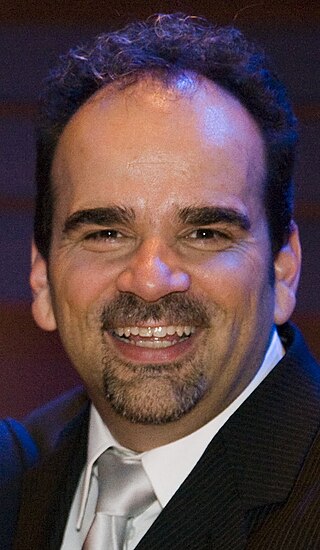
Siddhartha is an orchestral suite by Canadian composer Claude Vivier, which was completed in 1976. [1]

Siddhartha is an orchestral suite by Canadian composer Claude Vivier, which was completed in 1976. [1]
Vivier was commissioned to write an orchestral piece by the Canadian Broadcasting Corporation. He was inspired by Hermann Hesse's novel Siddhartha (1922), whose main character follows the teachings of Buddha. The work was completed in 1976, but it could not be premiered by the National Youth Orchestra of Canada under Marius Constant as planned, as they believed it was too difficult. [2]
It was finally premiered on 14 March 1987, four years after the composer's death, in Montreal, by the Orchestre Métropolitain under the direction of Walter Boudreau, one of Vivier's former classmates at the Conservatoire de musique du Québec à Montréal. [3]
The suite is written for an orchestra with the following instrumentation.

Le Tombeau de Couperin is a suite for solo piano by Maurice Ravel, composed between 1914 and 1917. The piece is in six movements, based on those of a traditional Baroque suite. Each movement is dedicated to the memory of a friend of the composer who had died fighting in World War I. Ravel also produced an orchestral version of the work in 1919, although this omitted two of the original movements.
Siddhartha or Siddharth is the birth name of the founder of Buddhism, Gautama Buddha.

Gilles Tremblay, was a Canadian composer from Quebec.

Claude Vivier was a Canadian composer, pianist, poet and ethnomusicologist of Québécois origin. After studying with Karlheinz Stockhausen in Cologne, Vivier became an innovative member of the "German Feedback" movement, a subset of what is now known as spectral music. He was also among the first composers in either Europe or the Americas to integrate elements of Balinese music and gamelan in his compositions, alongside Lou Harrison, John Cage and fellow Québécois Colin McPhee.

John Estacio is a contemporary Canadian composer of opera, orchestral and choral music.

Régis Campo is a French composer.

Timothy Wesley John Brady is a Canadian composer, electric guitarist, improvising musician, concert producer, record producer and cultural activist. Working in the field of contemporary classical music, experimental music, and musique actuelle, his compositions utilize a variety of styles from serialism to minimalism and often incorporate modern instruments such as electric guitars and other electroacoustic instruments. His music is marked by a synthesis of musical languages, having developed an ability to use elements of many musical styles while retaining a strong sense of personal expression. Some of his early recognized works are the 1982 orchestral pieces Variants and Visions, his Chamber Concerto (1985), the chamber trio ...in the Wake..., and his song cycle Revolutionary Songs (1994).

Paul Gilson was a Belgian musician and composer.
Neil Chotem was a Canadian composer, arranger, conductor, pianist, and music educator.
The Montreal Orchestra (MO) was a professional Canadian symphony orchestra based in Montreal, Quebec that was active from 1930–1941. While not Montreal's first orchestra, the MO is considered by music historians to be the first professional symphony orchestra in Montreal. Previous orchestras in that city were much smaller in size and, unlike the MO, utilized amateur musicians. The MO was the first ensemble in Montreal that employed only professional musicians, and the orchestra introduced Montreal's audiences to full symphonic programs for the first time. The ensemble gave the Montreal premieres of numerous works from the standard orchestral repertoire, including pieces by Beethoven, Berlioz, Brahms, Mendelssohn, Rachmaninoff, and Sibelius among others.
My Father Knew Charles Ives is an orchestral triptych by the American composer John Adams. The work was commissioned by the San Francisco Symphony. It was first performed by the San Francisco Symphony under the direction of Michael Tilson Thomas at the Louise M. Davies Symphony Hall on April 30, 2003.

The Quatuor Bozzini is a string quartet that specializes in new and experimental music based in Montreal, Canada.
"Shiraz" is a virtuosic piano piece by Claude Vivier, written in 1977. It is named after the eponymous Iranian city, and contains a flurry of interlocking rhythmic combinations and pulses at great speed. Vivier was inspired to write the piece after listening to blind singers perform in the city's market square. He wrote in the piece's program notes how he found Shiraz to be, "a pearl of a city, a diamond vigorously cut."
Lonely Child is a piece for soprano and orchestra by Claude Vivier, written in 1980. It is arguably his most well-known piece, and is considered a hallmark composition in the genre of spectral music.

Orion is a 1979 orchestral suite by Claude Vivier, inspired by the constellation of the same name. It is among the first compositions in Vivier's catalogue to delve into a unique compositional style he referred to as the jeux de couleurs. A typical performance lasts around thirteen minutes.
Kopernikus is a 1979 opera in two acts by Canadian composer Claude Vivier, inspired by the astronomer of the same name. It is the only opera of three that Vivier completed prior to his death in 1983. A typical performance lasts around seventy minutes.

Zipangu is a 1980 work for string orchestra by Canadian composer Claude Vivier. Inspired by traditional kabuki theatre, it is considered by many to be the composer's most aggressive and "unforgiving" piece, as it features a plethora of extended techniques for strings and denser harmonic content atop a complex melody, similar to the string compositions of Krzysztof Penderecki. A typical performance lasts around sixteen minutes.
Bouchara is a 1981 work for mixed chamber ensemble by Canadian composer Claude Vivier. It was originally intended to serve as an interlude for his unfinished opera Rêves d'un Marco Polo (1983-), but was published independently of the opera after weeks of deliberation. A typical performance lasts around twelve minutes.
Canadian composer Claude Vivier (1948–83) wrote four extant pieces for the tape recorder, in the musique concrète tradition established by French composer Pierre Schaeffer in the 1940s. Multiple other pieces from his career include the tape machine being used as an additional instrument to various ensembles. The majority of these compositions were a result of Vivier studying with Gottfried Michael Koenig at the Institute for Sonology in Utrecht.
Glaubst du an die Unsterblichkeit der Seele? is an unfinished 1983 chamber piece by Canadian composer Claude Vivier. It is one of his most famous compositions, as the libretto is claimed by some to have predicted the composer's own murder in March of the same year. The piece was left incomplete and unrevised with just three short movements, a typical performance lasting around eight minutes.